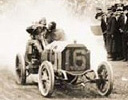November, 1999
Featured Question
After the tragedy at Fontana, many people have been searching for
the reasons behind it. And there have been a lot of facets of the situation that have been
mentioned. One of which is the Handford Device and the possibility that it causes the cars to
be too loose at such high speeds on the superspeedways. In retrospect, is the Handford Device
more trouble, safety wise, than it is worth? Or, is it being wrongly used as a scapegoat?
 There are pro's and con's to everything. Whether or not Handford causes more problems than it
solves is for people wiser than myself to decide. However, to "blame" Greg's death on it is
unfair, even if the device caused him to get loose. There needed to be pavement all the way to the
wall, and some sort of impact absorption.
Further, all of the drivers (particularly someone of Greg's caliber) know what it does and does
not do under various conditions. This was the 4th race it was run under (I believe). They
understood it. They all knew the chances they took with set up and various racing moves.
That said, it should be looked at for improvements IF THE DRIVERS THINK IT IS NEEDED. If not, we
need to trust them. They are the ones driving it, not us.
There are pro's and con's to everything. Whether or not Handford causes more problems than it
solves is for people wiser than myself to decide. However, to "blame" Greg's death on it is
unfair, even if the device caused him to get loose. There needed to be pavement all the way to the
wall, and some sort of impact absorption.
Further, all of the drivers (particularly someone of Greg's caliber) know what it does and does
not do under various conditions. This was the 4th race it was run under (I believe). They
understood it. They all knew the chances they took with set up and various racing moves.
That said, it should be looked at for improvements IF THE DRIVERS THINK IT IS NEEDED. If not, we
need to trust them. They are the ones driving it, not us.
Kevin Coulter (kjc@megsinet.net)
Woodridge, IL USA - Saturday, December 11, 1999 at 20:42:39 (PST)
Why did he lose it in the first place?
Answer - loss of downforce which translates to loss of tire grip.
Whose fault - No one unless you want to "blame" Greg for his set-up.
History and evidence: Greg Moore has always run well on the big ovals. Even before the hanford
device he ran with little downforce. This can be supported by the fact that he spun out in turn 2
at Michigan (almost the same place on the track as Fontana) at speed before, let me say that agin,
BEFORE the hanford devise was ever used. This has nothing to do with the hanford devise. No
matter what wing you use in CART you can still adjust it to the point of being out of control with
little downforce. Greg has done well at these tracks and has always been fast. He was
responsible for telling his crew what he wanted and he is responsible for the set-up. Greg simply
did not recover from this spin like he did at Michigan. That my friends is the answer why he spun
in the first place.
As far as why he died, the trasition from pavement to grass to pavement to grass flipped him. The
only way to keep the car from flipping is to pave the whole area. However, who is to say he would
not have died anyway hitting the wall at such a speed. The real issue here is how fast and hard
his car hit the wall. His body stopped to quick basically. The only options are designing a
better angle of a wall or protecting the wall with an energy absorbing device. Accidents will
happen and not all will be prevented. Safety must be an ongoing effort.
Mark Schuermann (schuermann@scripps.com)
Cincinnati, Ohio - Tuesday, November 30, 1999 at 08:06:01 (PST)
I think Ray may have hit the nail on the head as the turbulence caused by a small bunch of cars
when racing would be much less than that caused by a bunched field going into a re-start. With
the drivers chopping and changing their lines during this re-start for the best advantage it
necessarily follows that the air turbulence and characteristics would be all over the place in
comparison to a normal racing situation. It would be interesting if wind tunnel or computer
simulation tests could be run on some of the theories put forward.
Unfortunately, I also don't have an answer to the question except for the above suggestion.
Brian Pendlebury (brianandbev@optusnet.com.au)
Blair Athol, N.S.W. Australia - Monday, November 29, 1999 at 02:13:16 (PST)
I never liked the Handford idea. It's a band aid and yes it causes the cars to be a real
handfull ESPECIALLY on re-starts where cars are bunched up and still doing in excess of 200 mph.
Hearn blamed his crash at the same spot that greg went in, squarely on turbulence problems.
No rules change is going to solve the problem of racing a modern open wheel car such as CART and
yes IRL cars(notice how many IRL cars crash race after race and they run huge downforce at all
tracks except Indy) on any kind of banked oval track, They are simply too fast to be very safe.
I don't have a solution to this problem except to keep my fingers crossed and hope to God I won't
have to witness any more deaths.
Ray Dietz (rdietz@gte.net)
York, Pa USA - Thursday, November 18, 1999 at 08:02:15 (PST)
How can the hanford device be mentioned? The incidents were on restarts; if the hanford device
was a problem wouldn't the incidents be at speed not on the resarts? Anyway, isn't this the
second year for the device? Do away with the asphalt roads or the grass, you can't have both.
P.S. We still miss you Greg!
jeff burton (EmmoFan@aol.com)
indy, in usa - Tuesday, November 16, 1999 at 16:24:24 (PST)
|




